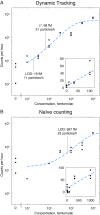Beating the reaction limits of biosensor sensitivity with dynamic tracking of single binding events
- PMID: 30782809
- PMCID: PMC6410873
- DOI: 10.1073/pnas.1815329116
Beating the reaction limits of biosensor sensitivity with dynamic tracking of single binding events
Abstract
The clinical need for ultrasensitive molecular analysis has motivated the development of several endpoint-assay technologies capable of single-molecule readout. These endpoint assays are now primarily limited by the affinity and specificity of the molecular-recognition agents for the analyte of interest. In contrast, a kinetic assay with single-molecule readout could distinguish between low-abundance, high-affinity (specific analyte) and high-abundance, low-affinity (nonspecific background) binding by measuring the duration of individual binding events at equilibrium. Here, we describe such a kinetic assay, in which individual binding events are detected and monitored during sample incubation. This method uses plasmonic gold nanorods and interferometric reflectance imaging to detect thousands of individual binding events across a multiplex solid-phase sensor with a large area approaching that of leading bead-based endpoint-assay technologies. A dynamic tracking procedure is used to measure the duration of each event. From this, the total rates of binding and debinding as well as the distribution of binding-event durations are determined. We observe a limit of detection of 19 fM for a proof-of-concept synthetic DNA analyte in a 12-plex assay format.
Keywords: biosensor; molecular recognition; nanophotonics; nanotechnology; single-molecule detection.
Conflict of interest statement
The authors declare no conflict of interest.
Figures




References
-
- Alix-Panabières C, Pantel K. Clinical applications of circulating tumor cells and circulating tumor DNA as liquid biopsy. Cancer Discov. 2016;6:479–491. - PubMed
-
- Alsdurf H, Hill PC, Matteelli A, Getahun H, Menzies D. The cascade of care in diagnosis and treatment of latent tuberculosis infection: A systematic review and meta-analysis. Lancet Infect Dis. 2016;16:1269–1278. - PubMed
Publication types
MeSH terms
Substances
LinkOut - more resources
Full Text Sources

